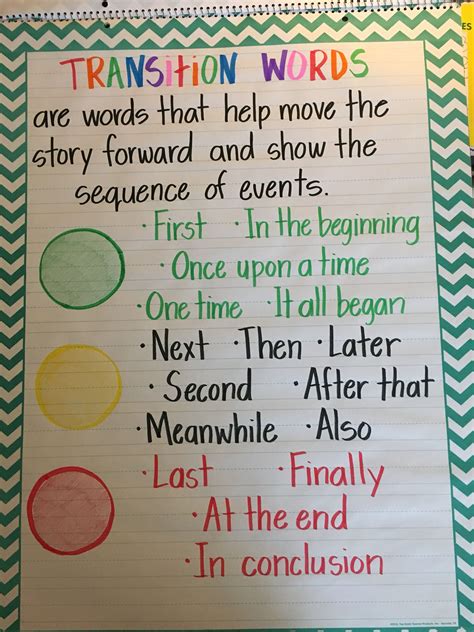Navigating the world of essay writing can be a daunting task, especially when it comes to ensuring smooth and coherent transitions between ideas. But fear not! Anchor chart transition words are here to guide you through this literary journey, empowering you to effortlessly connect your thoughts and ideas into a compelling narrative.

Anchor chart transition words are words or phrases that serve as verbal bridges, smoothly connecting various sections of an essay. They provide structure, cohesion, and direction to your writing, guiding your readers through your arguments and perspectives.
Transition words are essential for several reasons:
- Enhanced Coherence: They create a logical flow of ideas, helping readers follow your train of thought and grasp the connections between different points.
- Emphasis and Clarity: Transition words can emphasize key ideas and clarify relationships between sentences, ensuring your message is conveyed effectively.
- Improved Readability: When used judiciously, transition words make your writing more readable and enjoyable, reducing cognitive load and improving comprehension.
Selecting the most appropriate transition words depends on the specific context and the relationship between the ideas you’re connecting. Consider the following tips:
- Match the Purpose: Identify the type of transition you need (e.g., contrast, addition, cause-effect).
- Consider the Tone: Choose transition words that align with the tone of your writing, whether formal or informal.
- Variety is Key: Avoid using the same transition words repeatedly. Explore a wide range of options to create a dynamic and engaging flow.
To assist you in navigating this verbal haven, anchor chart transition words can be categorized into the following groups:
1. Addition
- Also
- Furthermore
- In addition
- Moreover
- Next
2. Contrast
- Alternatively
- By contrast
- However
- Conversely
- On the other hand
3. Comparison
- Similarly
- Likewise
- Comparatively
- In the same way
- Analogously
4. Cause and Effect
- As a result
- Consequently
- Therefore
- Thus
- Hence
5. Time
- After
- Before
- Afterwards
- Subsequently
- Later
6. Spatial
- Above
- Below
- Beside
- Near
- Far
7. Conclusion
- Finally
- In conclusion
- To sum up
- All in all
- In summary
For your convenience, here’s a comprehensive table summarizing the most commonly used anchor chart transition words:
| Category | Transition Words |
|---|---|
| Addition | also, furthermore, in addition, moreover, next |
| Contrast | alternatively, by contrast, however, conversely, on the other hand |
| Comparison | similarly, likewise, comparatively, in the same way, analogously |
| Cause and Effect | as a result, consequently, therefore, thus, hence |
| Time | after, before, afterwards, subsequently, later |
| Spatial | above, below, beside, near, far |
| Conclusion | finally, in conclusion, to sum up, all in all, in summary |
Transition words can do more than just connect ideas—they can also spark new ones. By analyzing the relationships between different transition words, you can generate ideas for novel applications:
- Contrast words (e.g., “alternatively,” “however”) could inspire you to explore alternative perspectives or create a thought experiment.
- Time-based words (e.g., “before,” “after”) could encourage you to examine historical context or anticipate future implications.
- Conclusion words (e.g., “finally,” “in conclusion”) could motivate you to summarize key points or draw insightful deductions.
Integrating anchor chart transition words into your writing is a simple yet effective way to enhance its quality. Follow these steps:
- Identify the Relationships: Determine the relationships between the ideas you’re connecting.
- Choose the Right Words: Select the most appropriate transition words based on the category and tone.
- Place Strategically: Position transition words carefully to guide readers seamlessly from one idea to the next.
- Variety and Balance: Use a diverse range of transition words to avoid monotony and create a natural flow.
Pros:
- Improved essay coherence and structure
- Enhanced clarity and readability
- Reduced cognitive load for readers
- Variety of options to match any writing style
- Usefulness as idea generators
Cons:
- Can be overused if not employed judiciously
- Potential for artificial or unnatural flow if not used thoughtfully
- Possible difficulty in choosing the most appropriate words for complex ideas
Anchor chart transition words are the linchpins of effective essay writing, providing the structural and logical support that enables your ideas to flow smoothly and effortlessly. By embracing these verbal connectors, you possess the power to captivate your readers, enhance the coherence of your arguments, and elevate your writing to new heights.
Remember, transition words are not mere accessories but essential tools that transform your prose into a coherent and compelling masterpiece. So, embrace them with confidence and unlock the doors to literary excellence!
